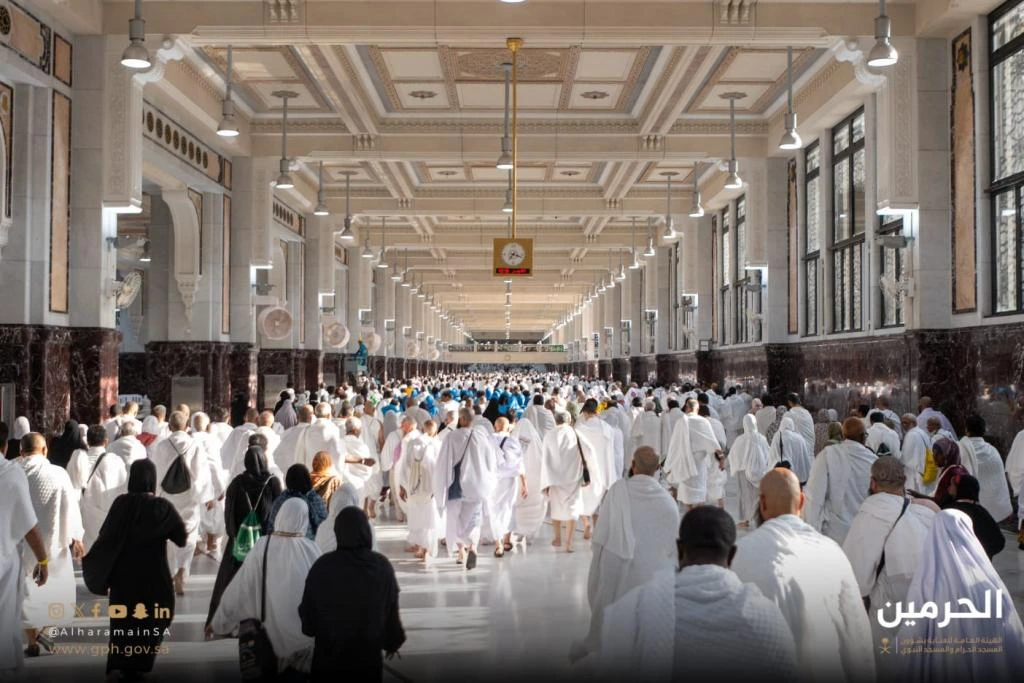
The Sa’i is the path extending between Safa and Marwah, located east of the Grand Mosque, and is an integral part of the Hajj and Umrah rituals as commanded by Allah in His Holy Book.
Safa and Marwah are two small mountains surrounding the Grand Mosque, where the Sa’i begins at Safa and ends at Marwah over seven laps, in accordance with Allah’s words: “Indeed, Safa and Marwah are among the symbols of Allah. So whoever performs Hajj to the House or Umrah, there is no blame upon him for walking between them. And whoever volunteers good – then indeed, Allah is Appreciative and Knowing.” (Surah Al-Baqarah 2:158).
Sa’i Between Safa and Marwah
The Sa’i between Safa and Marwah is an act of worship that reminds us of the profound faith of Hajar (peace be upon her), as she searched for water for her son Ismail (peace be upon him) in a barren valley without vegetation or water, with firm belief that Allah would not forsake her. Al-Bukhari narrated in his Sahih from Ibn Abbas (may Allah be pleased with them) the details of this moving scene.
Description of Safa and Marwah
Safa:
Located south of the Grand Mosque near “Safa Gate,” it is an elevated place, six meters long and three meters wide, accessible via four steps.Marwah:
Located northeast of the Grand Mosque at Mount Qaiqan, accessible via five steps connected to a platform.The Sa’i Path Through History
For centuries, the Sa’i path remained a dirt road until steps were built to facilitate climbing Safa and Marwah during the caliphate of Abu Ja’far al-Mansur.
It was later improved and paved to ease the performance of rituals. It is likely that the first to level and pave the Sa’i path was Caliph Muhammad al-Mahdi, who significantly expanded the Grand Mosque from all sides and personally oversaw the work of engineers and laborers. Subsequent rulers continued to maintain the Sa’i path as needed.
Developments in the Saudi Era (1932–Present)
-
Paving the Sa’i Path: In 1345 AH, King Abdul Aziz Al Saud, may Allah have mercy on him, ordered the paving of the Sa’i path with square stones to facilitate the Sa’i.
-
Renewal of the Sa’i Canopies: In 1366 AH, the canopy extending from Safa to Marwah was renewed to provide shade.
-
Sa’i Path Construction Project: In 1375 AH, the project to expand the Grand Mosque and the Sa’i path began to facilitate pilgrim movement.
-
Demolition of Marwah and Safa Arches: The cracked Marwah arch was demolished in 1376 AH, and the Safa arch in 1377 AH, to rebuild the steps.
Sa’i in the Modern Era
The Sa’i path continued to develop in the Kingdom, with modern facilities like air conditioning and advanced canopies providing comfort to pilgrims. Logistical systems were improved to ease movement and organize the Sa’i, enabling the area to accommodate large numbers of pilgrims safely and comfortably.
Conclusion
The Sa’i between Safa and Marwah is one of the holiest rituals, and the history of this area reflects a series of continuous developments from the Prophetic era to the modern Saudi era. These advancements have enhanced the Sa’i experience and met pilgrims’ needs, reflecting the Kingdom’s commitment to providing the best services to the guests of Allah with the highest standards of comfort and safety.